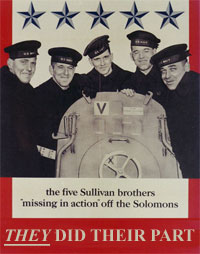Sullivan Brothers

On November 13th, 1942, the light cruiser USS Juneau (CL-52) was sunk by a Japanese torpedo during American efforts to resupply Marines holding the island of Guadalcanal.
On board Juneau were five brothers; Albert Leo Sullivan, Francis Henry Sullivan, George Thomas Sullivan, Joseph Eugene Sullivan and Madison Abel Sullivan. Four of the brothers were killed in the initial explosion that sunk the lightly-armored Juneau, and the fifth, George, died later in the water. Rescue efforts were delayed because of the Japanese presence in the area, and only a few Juneau survivors were eventually recovered.
The brothers had insisted on serving together in spite of pre-existing Navy policies (Bureau of Naval Personnel Information Bulletin No. 304) designed to prevent the sudden loss of multiple family members at one time.
Although the World War II era Navy attempted to prevent family members from serving together, this was never strongly enforced, and no regulations or legislation was ever passed preventing such assignments following the loss of the Sullivans.
Two Navy vessels have been named after the Sullivan brothers; the Fletcher class destroyer USS The Sullivans (DD-537) and the Arleigh Burke class destroyer USS The Sullivans (DDG-68).
Fact vs. Fiction
Reference to the Sullivan brothers is made in the War Department scene where General Marshall is informed of the deaths of three of the four Ryan brothers. The Sullivans were not the first group of brothers to have died at one time during wartime, but they became famous after their deaths, and are the most well-known case of multiple brothers being killed at one time in the U.S. military. Although the movie somewhat implies a change in policy or decision-making on the part of the military following the loss of the Sullivans, this is not in fact true. The plot of the movie, however, needs a reason for the Ryan brothers to have been split up, and the real-life loss of the Sullivans provides an event that justifies such an action.
